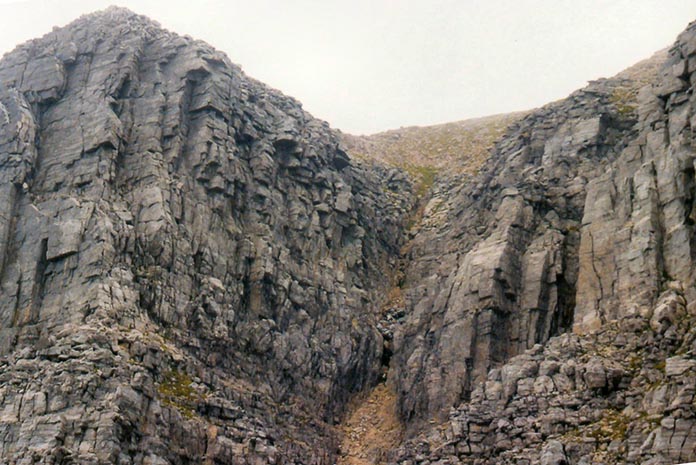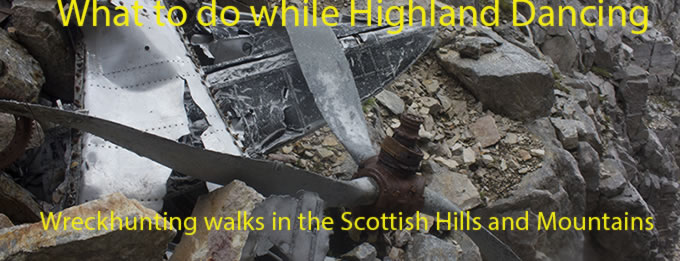Only Rock Climbers and Nutters
Avro lancaster TX264 on Beinn Eighe.
(Distance
covered = 11.6 mile/Ascent =+ 1186m)
Heather was dancing in the Canadian championships, so with her Mam they were off to Canada for the week. My plan was to drop them off at Glasgow Airport then head up north to some of the more remote crash sites in Scotland, then pick the girls up from the Airport on my way back a week later.
After leaving the girls at Glasgow Airport I continued on up the west coast for a considerable distance to Torridon, where I planned to camp overnight then have a very early start. My first target was Beinn Eighe for what would be my third attempt at reaching the crash site of Lancaster TX264 at the top of the Triple Buttress. On my previous two attempts, having encountered foul weather, I only managed to reach the wreckage lower down in the boulders below the Triple Buttress.
The path heading up between Liathach and Beinn Eighe
A 6am start and no deadline to pick the girls up, so as long as the weather behaved I was feeling optimistic in reaching my target. The top of Beinn Eighe is not a good place to be in poor visibility unless you have had fair weather experience up there, which up until now I hadn't, so I was keeping my fingers crossed.
From the car park on the A896 which is about 3 to 4 mile east of the village of Torridon there is a really well constructed path which makes its way up the Coire Dubh Mor between Beinn Eighe and Liathach. It then skirts around the northern slopes of Sail Mhor before turning right and ascending steeply up the side of some waterfalls to reach the out spill at the northern end of Loch Coire Mhic Fhearchair.
The path as it comes around the northern slopes of Sail Mhor with Carn Na Feola in the distance.
Waterfall that announces you are about to enter
Coire Mhic Fhearchair.
A Deer on Sail Mhor.
Above and below:-Triple Buttress from the top of the out spill at the northern end of Loch Coire Mhic Fhearchair.The normal route followed to reach the tops known as The Red Chute can be seen falling from the skyline on the left, of course I didn't go that way, I went up the gully known as Fuselage Gully which can be seen going up the right hand side of the Triple Buttress
The view as you enter Coire Mhic Fhearchair is impressive to say the least, the Loch is in it's own amphitheater, surrounded on 3 sides by Sail Mhor at 980m, Ruadh-stac Mhor at 1010m and Coinneach Mhor at 976m. This place has an atmosphere all of its own not least because straight ahead guarding the northern flank of Coinneach Mhor is the threatening bulk of the Triple Buttress.
Triple Buttress from the path around Loch Coire Mhic Fhearchair.The Lancaster wreckage is scattered in the area outlined in Yellow
Once into the Coire there is a slightly rougher and boggier path that leads around the eastern shore of the loch towards the boulder fields below the Triple Buttress. At the southern end of the Loch, with the Triple Buttress looming large and forboding above you, most walkers heading for the top of Beinn Eighe veer off to the left up a path that zigzags its way up some terraces before reaching the ridge between Ruadh-stac Mhor and Coinneach Mhor, via a gully known as the Red Chute. I veered off to the right up a steep and rugged boulder field which is littered with pieces of Lancaster.
Above and below:-Most commonly used route to the top of the Beinn Eighe Ridge above; the route I took up fuselage gully which is the gully near the centre of the photo below.
Large chunk of wing. some of the RAF roundel can still be seen
Hundreds of pieces of Lancaster can be found in amongst the boulders including some quite large bits and all four engines. As well as what can be seen there is almost certainly a considerable amount hidden under boulders. Since I last visited this area 12 years ago everything had been moved downhill by the actions of shifting boulders and snow and there was lots of pieces that had been uncovered.
2 of the four Merlin engines these two are near the path at the bottom of the boulder field
3rd Merlin engine, the higher up the slope they are the more damaged
Part of the 4th engine, this one is just below the entrance to Fuselage Gully, the other bank of cylinders from this engine is up the top of fuselage gully.
One of the props, a second is higher up the slope, a third is wedged in the top of fuselage gully and the fourth has been recovered and used as a memorial at RAF Kinloss
The 2nd prop, higher up the slopes it is in poorer condition than the other two remaining on site.
On my first two visits to this site there was no sign of the 2nd prop which is just below the entrance to fuselage gully, probably because it was covered in boulders . This is the only wreck site I have been to where there has been more stuff too see than on previous visits.
A carburetor from one of the engines in Fuselage Gully.
Fuselage Gully runs up the western side of the Triple Buttress, near the top it branches of at 90 degrees
where it becomes even steeper, its not a place for the faint hearted. The first time I came up here the going was much easier as it was full of quite large boulders but this time they had all spilled out the bottom leaving mostly loose scree and wet mossy slabs to negotiate.
On the positive side this had uncovered a lot more pieces of the Lancaster including a large lump of carburetor.
Lancaster wreckage including a prop is wedged 2/3rds of the way up the section of gully where it branches of to the left.
This gulley would have been a much shorter route to take but there is a 40ft vertical drop immediately below the wedged wreckage which necessitates climbing gear which i didn't have, so i had to continue off to the right and around the back to get at it from above.
Fuselage Gully where it branches off to the left.
Just past where the gully branches to the left I had to extricate myself from fuselage gully, the easiest way was to climb up the slope on the opposite side of the gully which although very steep was mostly grass and heather, so wasn't a problem. On my first visit here back in the 1990's I chickened out from going any further once I reached the top of fuselage gully as the rocks above were all shrouded in cloud, instead I droppd straight over the ridge and down the other side as it looked quite easy going to get back down to the path below; it wasn't!
above and below:-Looking back down into Coire Mhic Fhearchair from near the top of Fuselage Gully
Once onto the ridge between Coinneach Mhor and Sail Mhor you are confronted with a vertical face of rock which must be about 100ft high and unless you are an accomplished rock climber means a further diversion. There is a path that leads around the west of the Buttress leading to another less severe gully, this gully involves an easy scramble up onto the summit plateau then there is a short walk back to the north west to reach the crash site of TX264 and to enter Fuselage Gully from above.
Following the path around the western side with Liathach as a backdrop.
The crash site of the Lancaster is only 15 feet from the top of the ridge which means if they had been only 20 feet higher they may have continued on their way none the wiser!.
Where the Lancaster struck the mountain, a lot of it fell or was pushed by the recovery crew into Fuselage Gully on the right.
There is a lot of the Lancaster scattered around up here as well and even more down the top reaches of Fuselage Gully. It is a very steep descent into fuselage gully with loose boulders and scree and pieces of jagged metal to negotiate, hard hats would definitely be advisable if there was more than one person going down into here!.
An engine bearer hanging precariously over the precipice.
A large piece of wing spar with an engine bearer still attached. Sail Mhor in the background
The Tail wheel of the Lancaster, this is hanging precariously over the 40ft drop which prevents scrambling straight up the gully from below.
Looking back up the top reaches of fuselage gully, only rock climbers and Nutters venture into here.
Rock climbers often mention using this prop to belay off, I didn't think it was wedged that securely
The black painted part the prop is bent around is one of the twin vertical stabilizers and rudder from the tail of the Lancaster.
After spending a couple of hours photographing everything the weather decided it was time I went and provided me with some very high winds and rain that fancied itself as hailstone as encouragement. The fantastic views I was looking forward to while traversing the tops to make my descent down the Red Chute were lost in some nasty cloud and gusts of wind which must have been somewhere in the regions of 50+mph meant I had to keep diving to the ground to avoid being blown off the ridge.
Looking back to The Red Chute after my descent,with the tops of the ridges now obscured by cloud the atmosphere in the Coire was even more oppressive
One interesting aspect of the high winds was the effect on the numerous waterfalls passed while traversing the terraces leading down from the Red Chute, at first it looked like smoke rising from a fire but when I was closer I realized it was the waterfalls being blown up into the air by the high wind, unfortunately just as I was passing one such airborne waterfall the wind direction veered and the contents of the waterfall was deposited on my head!

